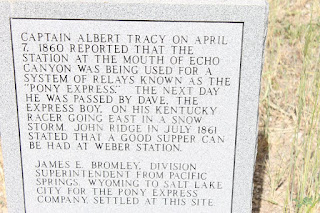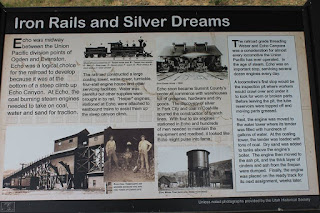On the road to Iosepa, Utah in Tooele County. On the way out there, we had to pull over and get this pic. Power-lines with no power lines is definitely ghosty. :)
This little piece of Skull Valley is where you can find the cemetery of Iosepa. (Yo-see-pah) It means "Joseph" in Hawaiian.
Polynesian converts to the Church of Jesus Christ of Latter-day Saints came to Salt Lake City in the late 1800's. The church scouted a place for them to settle (I think it was purchased by the Iosepa Agricultural and Stock Company) and the first 46 settlers moved into Iosepa in 1889. H.H. Cluff was made stake president, and responsible for the management of the town... so I guess that means he was the mayor?
Utah Enquirer reports 100 residents in November 1889.
It was a hard place to live, but
Deseret Weekly and Deseret Evening News in December 1894 reported the town was doing well, tho some people returned to the Sandwich Islands. The town had an 11 acre public square. They built canals, raised crops, worked at the saw mill, had a school, houses, and a meetinghouse.
In 1914 the town had reached a peak population of
150. The
Deseret Evening News makes it sound quite green! In 1909 there was talk of building a post office and having a school district in Skull Valley.
They built canals, raised crops, and
won a prize as the "most progressive city in Utah" in 1911.
 |
| Each lot of the town had a fire hydrant. There used to be fire hydrants in the sagebrush, but I think this historical marker protects the only one left. |
The town died six years later when the La'ie Hawaii temple was being built. Most residents returned to Hawaii to help with the temple construction. The property was sold to Deseret Livestock Company, and eventually the structures were buried and the land plowed. I'm not quite sure when the town became a complete ghost, because I found a postmaster announced for Iosepa in 1919 and a
teacher in 1923. However, the cemetery remains, and from the look of things, it is not a forgotten place.
Bibliography:
https://historytogo.utah.gov/places/iosepa.html
https://en.wikipedia.org/wiki/Iosepa,_Utah
http://utahstories.com/2011/08/iosepa-mystery-utahs-hawaiian-pioneer-town/
https://www.ksl.com/?sid=27432550
https://newspapers.lib.utah.edu/details?id=2244696&q=Iosepa&year_start=1908&year_end=1919&facet_type=%22article%22
https://newspapers.lib.utah.edu/details?id=2292185&q=Iosepa&year_start=1908&year_end=1919&facet_type=%22article%22
https://newspapers.lib.utah.edu/details?id=2354653&q=Iosepa&year_start=1908&year_end=1919&facet_type=%22article%22







 The train brought life to this town. There was a saloon (I read of 7 skeletons found when the saloon was excavated, but cannot find anything discovered regarding the cause of death, or where the remains were laid to rest), brothels, homes of adobe, school house, church, and railroad maintenance structures. There are many historical markers and stops up Echo Canyon, and a museum just a few miles up the road in Henefer.
The train brought life to this town. There was a saloon (I read of 7 skeletons found when the saloon was excavated, but cannot find anything discovered regarding the cause of death, or where the remains were laid to rest), brothels, homes of adobe, school house, church, and railroad maintenance structures. There are many historical markers and stops up Echo Canyon, and a museum just a few miles up the road in Henefer. 





































